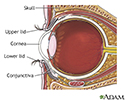Pinguecula
A pingueculum is a common, noncancerous growth of the conjunctiva. This is the clear, thin tissue that covers the white part of the eye (sclera). The growth occurs in the part of the conjunctiva that is exposed when the eye is open.
The exact cause is unknown. Long-term sunlight exposure and eye irritation may be factors. Arc-welding is a major job-related risk.
Symptoms
A pingueculum looks like a small, yellowish bump on the conjunctiva near the cornea. It can appear on either side of the cornea. However, it more often occurs on the nose (nasal) side. The growth may increase in size, but usually over many years.
Exams and Tests
An eye exam is often enough to diagnose this disorder.
Treatment
The only treatment needed in most cases is the use of lubricating eye drops. Keeping the eye moist with artificial tears may help prevent the area from becoming inflamed. Temporary use of mild steroid eye drops can also be helpful. Rarely, the growth may need to be removed for comfort or for cosmetic reasons.
Outlook (Prognosis)
This condition is noncancerous (benign) and the outlook is good.
Possible Complications
The pingueculum may grow over the cornea and block vision. When this happens, the growth is called a pterygium. These two conditions occur under similar conditions. However, they are thought to be separate diseases.
When to Contact a Medical Professional
Contact your health care provider if the pingueculum changes in size, shape, or color, or if you would like to have it removed.
Prevention
Things you can do that may help prevent a pingueculum or keep the problem from getting worse include:
- Keeping the eye well lubricated with artificial tears
- Wearing good quality sunglasses
- Avoiding eye irritants
References
American Academy of Ophthalmology website. Pinguecula and Pterygium. www.aao.org/eye-health/diseases/pinguecula-pterygium. Updated May 10, 2024. Accessed October 29, 2024.
Cioffi GA, Liebmann JM. Diseases of the visual system. In: Goldman L, Cooney KA, eds. Goldman-Cecil Medicine. 27th ed. Philadelphia, PA: Elsevier; 2024:chap 391.
Reidy JJ. Corneal and conjunctival degenerations. In: Mannis MJ, Holland EJ, eds. Cornea. 5th ed. Philadelphia, PA: Elsevier; 2022:chap 75.
Shtein RM, Sugar A. Pterygium and conjunctival degenerations. In: Yanoff M, Duker JS, eds. Ophthalmology. 6th ed. Philadelphia, PA: Elsevier; 2022:chap 4.9.
Review Date: 10/2/2024







